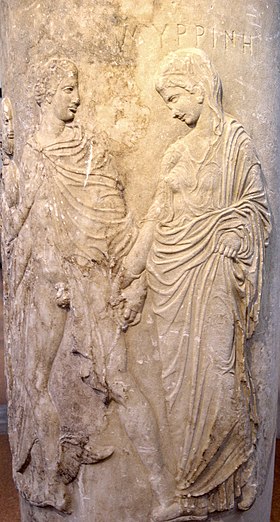Psychopomp

Psychopomps (from the Greek word ψυχοπομπός, psychopompós, literally meaning the "guide of souls")[1] are creatures, spirits, angels, or deities in many religions whose responsibility is to escort newly deceased souls from Earth to the afterlife. Their role is not to judge the deceased, but simply to guide them. Appearing frequently on funerary art, psychopomps have been depicted at different times and in different cultures as anthropomorphic entities, horses, deer, dogs, whip-poor-wills, ravens, crows, vultures, owls, sparrows and cuckoos. When seen as birds, they are often seen in huge masses, waiting outside the home of the dying.
Overview[edit]
Ancient religion[edit]
Classical examples of a psychopomp are the ancient Egyptian god Anubis, the god Yama in Hinduism, the Greek ferryman Charon[1] and deities Hermes and Hecate, the Roman god Mercury, the Norse Valkyries, and the Etruscan deity Vanth.
Modern religion[edit]
The form of Shiva as Tarakeshwara in Hinduism performs a similar role, although leading the soul to moksha rather than an afterlife. Additionally, in the Bhagavata Purana, the Visnudutas and Yamadutas are also messengers for their respective masters, Vishnu and Yama. Their role is illustrated vividly in the story of Ajamila. In many beliefs, a spirit being taken to the underworld is violently ripped from its body.[2]
In the Persian tradition, Daena, the Zoroastrian Self-guide, appears as a beautiful young maiden to those who deserve to cross the Chinvat Bridge or a hideous old hag to those who do not.[3]
In Islam, Azrael plays the role of the angel of death who carries the soul up to the heavens.[4]
The polytheistic concept of a specific deity of death is rejected by Judaistic monotheism because only God is regarded the master of death and of life [5].
In many cultures, the shaman also fulfills the role of the psychopomp. This may include not only accompanying the soul of the dead, but also to help at birth, to introduce the newborn child's soul to the world.[6](p36) This also accounts for the contemporary title of "midwife to the dying", or "End of Life Doula", which is another form of psychopomp work.
In Filipino culture, ancestral spirits (anito) function as psychopomps. When the dying call out to specific dead persons (e.g. parents, partners), the spirits of the latter are supposedly visible to the former. The spirits, who traditionally wait at the foot of the deathbed, retrieve (Tagalog: sundô) the soul soon after death and escort it into the afterlife.[7]
The banshee of Irish and Scottish folklore fits the role of a psychopomp; she keens and laments three nights in a row to warn families of impending deaths and to guide the soul of the recently dead to the Afterlife.
In Christianity, Saint Peter, Michael the Archangel and Jesus are thought of as psychopomps either as leading the dead to heaven or, as in the case of Peter, allowing them through the gates.[8]
Psychology[edit]
In Jungian psychology, the psychopomp is a mediator between the unconscious and conscious realms. It is symbolically personified in dreams as a wise man or woman, or sometimes as a helpful animal.[9]
Popular culture[edit]
The most common contemporary example of a psychopomp appearing in popular culture is the Grim Reaper, which dates from 15th-century England and has been adopted into many other cultures around the world over the years; for instance, the shinigami in Japanese culture today.[a]
Notes[edit]
- ^ Exemplified by the popular manga and TV drama series Death Note
References[edit]
- ^ a b "ψυχοπομπός - Henry George Liddell, Robert Scott A Greek-English Lexicon". Perseus.tufts.edu.
- ^ "The Mercury-Woden Complex: A Proposal", p. 27
- ^ Zoroastrianism After Life. Zoroastrian Funeral. Accessed: March 2017.
- ^ "Death, angel of". Jewish Encyclopedia. Retrieved 2017-02-02.
- ^ "Angel of Death". Jewish Virtual Library. Retrieved 2020-05-04.
- ^ Hoppál, Mihály: Sámánok Eurázsiában. Akadémiai Kiadó, Budapest, 2005. ISBN 963-05-8295-3. (The title means "Shamans in Eurasia"; the book is written in Hungarian, but it is published also in German, Estonian and Finnish.) Site of publisher with short description on the book (in Hungarian) Archived 2010-01-02 at the Wayback Machine.
- ^ Scott, William Henry (1994). Barangay: Sixteenth Century Philippine Culture and Society. Quezon City: Ateneo de Manila University Press. ISBN 971-550-135-4.
- ^ "Jewish Myth, Magic, and Mysticism: Knock, Knock, Knocking on Heaven's Door: Jewish Psychopomps". ejmmm2007.blogspot.com. Retrieved 2020-04-02.
- ^ Drake, Michael. The Great Shift: And How To Navigate It. (2018) pp. 82. ISBN 0-9629002-9-X
Further reading[edit]
- Geoffrey Dennis, "Abraham", "Elijah", "Lailah", "Sandalphon", Encyclopedia of Jewish Myth, Magic, and Mysticism, Llewellyn, 2007.
- Eliade, Mircea, "Shamanism", 1964, Chapters 6 and 7, "Magical Cures: the Shaman as Psychopomp".
External links[edit]
 Media related to Psychopomps at Wikimedia Commons
Media related to Psychopomps at Wikimedia Commons